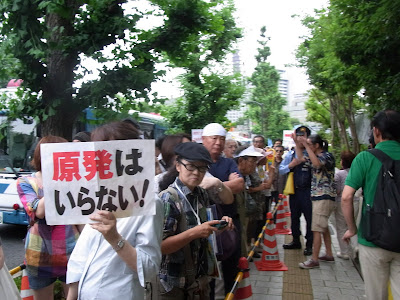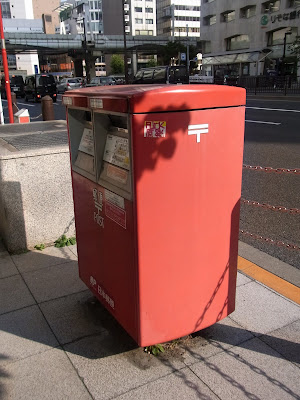Much more than last year, this year is being characterised by systematically organised protests.
Last week and the week before I went to the protests at Kokkai Gijidou Mae - outside the Prime Minister's official residence. I was there more to see what was happening rather than to protest. I can't say I'm unequivocally in the anti nuclear camp, though obviously the current situation in Fukushima is completely unacceptable.Anti nuclear power protests have a long history in Japan, particularly with the legacy of Hiroshima and Nagasaki. Government efforts to subdue the protests has an equally long history. (see this article by Daniel Aldrich for an insight into the way the government has operated to get nuclear established.) In some ways the protests are about much more than nuclear, they seem to be about democratic fundamentals. Having said that though, I am not sure how widespread the sentiments are; I have heard few reports of protests in other areas. It will be interesting to see the next election.
 |
| The same people being turned away. We were on the same side of the road as the PM house, about 70 m. from where we were. |
 |
| Protestors were told strictly by organizers that any speeches must only relate to the anti nuclear agenda. A key strategy of successful protesting - keeping a clear target. |
 |
| The Diet building in the background with police and baricades between it and the people.... symbolic really when you consider that there has been negligible attention been paid by politicians. |
 |
| Graffiti on a post box - "Fuck Nuclear Power". Intersetingly written on what looks like a beginners English name tage. |
 |
| I met up with a friend and fellow blogger Rurousha to go on the 27th July 2012 protests. We met in Hibiya Park, which is often a site for protests, though the size is too small to have large rallies. |
 |
| A marshalling point for participants? Just near the Ministry of Industry (METI) building, between Hibiya Park and the Diet, a group of protestsers had set up shop. |

Police keep protestors on a very light leash. Protesters can't move
out of the "protesters area". One side of the foot path is shut off
to enable people to walk along the footpath, but since there is almost
no pedestrian traffic, it serves a double bonus purpose as
preventing protesters from congregating in a more condensed area.
For Rurousha's account with an African perspective, see
http://rurousha.blogspot.jp/2012/07/nuclear-protesters-you-have-to-learn.html











2 comments:
Your photos make it clear that the first protest was much bigger. (That iPad takes great photos, by the way!)
The next election will be very interesting. Recently much has been made in the media of anti-nuclear Iida Tetsunari's defeat in Yamaguchi (a bit earlier another anti-nuclear candidate lost in Kagoshima), but I'm not convinced this means anything. Both candidates were inexperienced compared to their opponents, and I don't know if voters would want to focus exclusively on nuclear power plants while so much else needs attention. We'll see.
I enjoyed our southern insurgency enough to volunteer for the next one! :)
It was bigger... tonight one of my profs from Sophia posted a video of tonight's protest - more drums and it seemed that people were able to walk. I've just asked him about it but haven't heard back yet.
Yamaguchi I think there were other factors - that the anti nuke guy was a single issue campaigner. The article by Daniel Aldrich that I linked to in this post is a really interesting read.
I'd like to go back and see it again to see if and how the dynamics change. Lekkerly interesting. Arigatou!
Post a Comment